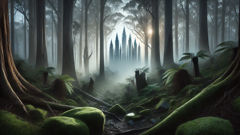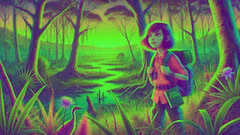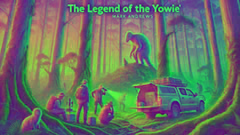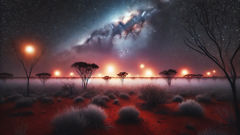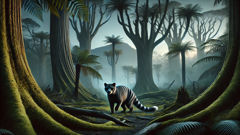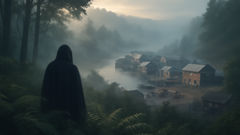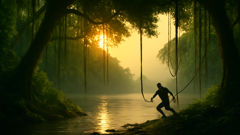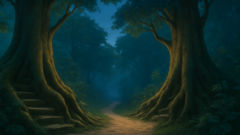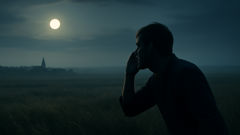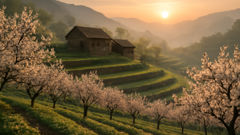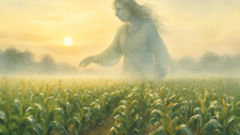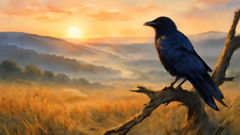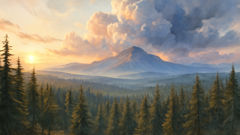Introduction
Mist drifts through the towering gums of the Dandenong Ranges like a living memory, winding between centuries-old tree ferns and ancient moss-cloaked stones. In the hush before dawn, the forest feels untouched by time, and the calls of lyrebirds echo across deep gullies. The world beyond these rolling hills—where Melbourne sprawls and the clamor of modern life never quite stops—feels impossibly distant. For as long as people have walked these shadowy trails, stories have clung to the slopes. Some are old as the Wurundjeri, the first custodians of this land; others belong to settlers or lost wanderers, each adding a layer to the hills’ silent magic. Yet none is whispered so often, or with such wide-eyed wonder, as the legend of the Glass City: a place of dazzling spires and floating bridges, woven from light and mist, that’s said to appear only when the mountains are swaddled in fog thick enough to blur the line between waking and dreaming. On rare mornings, it’s told, a lucky few might stumble upon the city’s spectral towers—translucent domes rising amid the eucalypts, lanterns flickering from inside crystalline halls. Some claim the city is a mirage born of yearning, a trick of dew and sunlight; others insist it’s the vestige of an ancient civilization, hidden by enchantment. No two accounts agree on what’s seen within those fleeting moments, but all who’ve chased the vision come away changed. Among the winding trails and tangled undergrowth, the Dandenongs keep their secrets close. This is the story of Eliza Hart, a botanist with an eye for the uncanny, whose search for a rare orchid leads her into the heart of the legend. As she learns, in these forests, truth and myth are branches of the same great tree—intertwined, enduring, and waiting to be found.
Chasing Shadows and Stories
Eliza Hart never set out to chase legends. Her world was one of pressed flowers, Latin names, and early-morning fieldwork, notebook always within reach. She’d grown up at the foot of the Dandenongs, her childhood spent scrambling through fern-filled gullies and listening to her grandmother’s stories by the fire. The Glass City was just another tale—one she’d filed away with bunyips, drop bears, and other bushland mysteries. But as the years passed, the stories began to feel less like fantasy and more like echoes of something half-remembered.
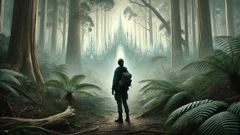
On a chill July morning, Eliza woke before sunrise, pulled on her boots, and stepped into the darkness. She was hunting Caladenia astarte, the elusive Starry Spider Orchid, rumored to bloom for a single week each winter somewhere along the cool ridges above Olinda. She followed a faint track, boots crunching through damp leaf litter, her torch catching the sudden glint of dew on silvered bracken. The air was thick with fog, swallowing her footsteps and muffling the world. Her breath mingled with the mist. With every step, the trees grew taller and the hush deeper.
It was then she heard it—a sound like distant bells, impossibly delicate. She paused, heart thudding. The world seemed to hold its breath. The fog shifted, and for a heartbeat, Eliza saw something impossible: tall, slender towers rising among the trees, their surfaces glimmering as if spun from ice or moonlight. Bridges arched between them, thin as cobwebs, and shapes moved within the glow. She blinked, and the vision wavered. The forest pressed close again, but the memory of that shimmering city had already taken root.
Shaken, Eliza crouched by a fallen log and tried to convince herself it was just exhaustion or a trick of the light. But the sound of bells lingered in her ears, and she couldn’t shake the sense of having crossed some invisible threshold. The orchid hunt was forgotten. Instead, she began wandering toward where the vision had been—a direction that felt as much dream as compass. The forest grew denser. Twisted vines hung low, and the ground sloped beneath her feet. Every so often, she’d catch a glint through the fog, something bright and quick as a thought, but when she tried to focus, it vanished.
By midday, Eliza had lost all sense of time. The sun was just a dull glow above the mist. She found herself standing before a broad gully choked with ferns and ghost gums, the air thick with the scent of damp earth and lemon myrtle. She could hear water trickling somewhere out of sight. Here, she found the first clue: an old stone bench, slick with moss, inscribed with a pattern that reminded her of glasswork she’d seen in museums. Next to it, a faded plaque bore words almost erased by time: ‘Seek where light bends and silence deepens.’
Eliza traced the inscription with her gloved fingers, feeling a thrill of recognition. This was no mere resting place; it was a marker—left by someone who’d seen what she’d glimpsed. Emboldened, she pressed on, trusting her instincts and the faint trail of clues. The forest seemed to lean in, listening. Her path curved past ancient tree ferns whose fronds brushed her shoulders like the fingers of giants. Occasionally, she’d spot a stone cairn or a heap of glassy pebbles, as if someone had been laying breadcrumbs for those who knew what to look for.
By late afternoon, Eliza’s feet were aching, but curiosity kept her moving. She broke through a stand of mountain ash and found herself at the edge of a small clearing. The fog was thinning now, but at its heart, something shimmered—a structure so delicate it seemed woven from rain. It looked nothing like any building she’d seen: spires arched like lily petals, walls glimmered with colorless fire. She stepped forward, heart racing, and the vision seemed to pulse in response, brighter and more real with every step.
Her phone camera wouldn’t focus; every image turned out blurred or empty. It was as if the city didn’t want to be captured—only witnessed. The air was warmer here, sweet with the scent of unseen flowers. She wandered deeper into the clearing, feeling a strange weightlessness, as if gravity had loosened its grip. For a moment, the world spun with possibility.
And then, just as suddenly as it had appeared, the city faded, retreating into mist. Eliza stood alone in the clearing, the last echoes of the bell-like music fading away. She knelt, feeling the earth for something tangible, and her fingers closed around a single fragment of glass: curved, cool, and etched with the same pattern as the stone bench. Proof—or perhaps a message. She turned it in her hand, wondering how much of what she’d seen was real, and how much was the forest’s gift to those willing to believe.
Echoes in Glass and Mist
The days that followed tugged at Eliza’s sense of reality. The memory of the Glass City haunted her waking hours and stole into her dreams. She returned to her rented cottage on the outskirts of Sassafras, pouring over old field guides and dusty local histories. She traced maps of the Dandenongs on her kitchen table, marking every place where legend or rumor hinted at something strange—a shimmer in the mist, a ring of singing stones, the laughter of invisible children at twilight.
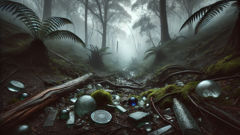
Her grandmother’s stories echoed in her mind. ‘The mountains keep their treasures for those with patience,’ she’d once said, her voice soft as a lullaby. Eliza wondered if that had been a warning or an invitation. She began reaching out to others: fellow botanists who’d spent decades in the ranges, Wurundjeri elders who spoke of places where spirits gathered, even urban explorers who mapped abandoned quarries and forgotten logging tracks. Most were skeptical, but a few listened with open minds. Some recounted their own strange encounters—a path that vanished into thin air, a moment when time seemed to double back on itself, glimpses of light dancing through fog.
One night, Eliza sat by her window as rain pattered against the glass and scrolled through local forums. Buried deep in a thread about ‘bush oddities,’ she found a post from a man named Theo, claiming he’d seen ‘the city of glass’ as a child, and again as an old man. The details were eerily familiar: the bell-like music, the sensation of weightlessness, the vanishing act when dawn broke through. They arranged to meet at a tea house tucked between antique shops in Olinda. Theo was wiry, with wild white hair and eyes that crinkled when he smiled. He brought along a battered notebook full of sketches and cryptic notes.
Over steaming cups of mountain-grown tea, Theo described his first encounter. He’d wandered away from his father’s woodcutting camp one morning after rain, drawn by strange music. ‘I saw towers tall as gum trees and bridges like rainbows,’ he whispered. ‘Thought it was a fever dream, till I found this.’ He slid a fragment of glass across the table—etched with the same looping design as Eliza’s. She shivered.
They compared notes. Both had seen the city only when the fog was thickest. Both felt an urge to move deeper, to seek its heart. Theo speculated that the city existed in a liminal space—a crease between worlds, visible only to those tuned to its frequency. ‘Maybe it’s a memory,’ he mused. ‘Or maybe it’s hope. The forest wants us to remember what we’ve forgotten.’
Armed with new purpose, Eliza returned to the mountains with Theo. They retraced their steps by lantern-light, marking places where the boundary between ordinary and extraordinary felt thinnest. Sometimes they’d hear music; other times, they’d find signs—a patch of ground where frost lingered long after sunrise, or a circle of mushrooms that pulsed faintly with blue-green light at dusk. Eliza collected more fragments: curved glass beads, a smooth shard shaped like a leaf, a tiny crystal bell that rang with no wind at all.
As winter deepened, word of their search spread among hikers and locals. Some scoffed; others brought their own tales—a bushwalker who glimpsed figures moving within a haze on Sherbrooke Track, a child who’d followed glowing footprints before being called back by his mother. Eliza’s collection grew: sketches, recordings of music on misty mornings, even a faded photograph from the 1920s showing a ghostly shape among the ferns.
But not all who sought the city were welcome. One afternoon, Eliza and Theo stumbled upon a group of treasure hunters—loud, brash, trampling delicate undergrowth in search of ‘the fortune in the fog.’ The air grew heavy; the mist thickened until they lost all sense of direction. When they finally emerged into sunlight, hours had passed and they’d found nothing but damp clothes and bruised egos. Eliza realized the legend protected itself, allowing entry only to those who approached with wonder, not greed.
The search became less about finding proof and more about honoring the mystery. Eliza began to notice changes in herself—an attunement to the subtle rhythms of the bush, a heightened sense of connection to the land’s stories. She learned to read the language of shadows and dew, to listen for the city’s song in the silence between raindrops. Some mornings, she’d catch a glimpse of glass towers out of the corner of her eye, or feel the warmth of unseen lanterns when the fog pressed close. Each encounter was fleeting but transformative.
Through it all, the forest seemed to watch and wait. Eliza started writing her own account—part field journal, part folktale—hoping to capture not just what she’d seen, but what she’d felt: the sense that the Glass City was not just a place but a promise, a reminder that wonder survives wherever people are willing to seek it.
The City’s True Heart
Spring crept over the Dandenong Ranges like a gentle tide. Wattle bloomed gold against the green, and the air buzzed with cicada song. Eliza had settled into a new rhythm: mornings spent cataloguing her findings, afternoons exploring lesser-known tracks with Theo or alone. She still searched for the Starry Spider Orchid, but the city’s mystery had become her guiding star.
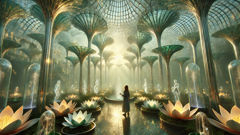
One warm evening in early September, Eliza awoke from a restless sleep with an idea—a sudden certainty that she should return to the old stone bench at dawn, just as the first light touched the trees. She left a note for Theo and set out before sunrise, her boots crunching over damp leaves. The world was wrapped in pearl-grey mist, silent but for the drip of condensation from high branches.
When she reached the bench, she found a new clue: a tiny bell-shaped flower growing at its base, unlike any she’d seen before—its petals translucent and veined with silver. As she knelt to study it, a wave of music washed over her: not just bells this time, but voices—soft and layered, singing in a language she didn’t know but somehow understood. The fog thickened around her, the air pulsing with light.
Eliza stood and stepped forward. With each stride, the world changed: trees stretched impossibly tall, their trunks reflecting colors she’d never seen; ferns shimmered like spun glass. She crossed a bridge that hadn’t been there before—delicate as dew but strong underfoot. The city unfolded around her: domes that caught the sunrise in a thousand facets, plazas where silver fountains played music in their splash. Figures moved within the glow—tall and slender, dressed in robes that shifted hue with every breath of wind. Some turned to watch her, eyes bright with welcome. One stepped forward and pressed a hand to her heart. In that instant, memory flooded her—a vision of the land before roads and houses, when spirits danced with lyrebirds in dawn’s first light.
She wandered through the city, seeing wonders that defied description. Lanterns floated above walkways; gardens bloomed with impossible flowers; a library held books made from leaves of crystal. She sensed, rather than heard, that this place was old—older than any story or song. It had survived because it adapted: hiding in mist, revealing itself only to those who approached with reverence. The city was not just built from glass; it was built from hope, from memory, from every whispered wish and every forgotten promise.
Eliza understood that she could not stay forever. The city was a threshold—meant to be crossed only for a moment, to remind visitors of what endures beneath the rush of daily life. She left with her arms full: a new sketchbook of wonders, a heart brimming with music, and that tiny glass bell-flower tucked behind her ear.
When she emerged from the mist into ordinary daylight, the world seemed both brighter and more fragile. Theo was waiting by the path, worry and relief mingling on his face. She tried to explain what she’d seen, but words seemed inadequate—how could you describe a city built from possibility? Instead, she pressed the glass flower into his palm and smiled. He understood.
In the months that followed, Eliza became a quiet legend herself—‘the girl who walked in glass.’ Her fieldwork took on new meaning; her lectures filled with stories that blurred fact and folklore. She taught children how to look for wonder in dew and shadow, how to listen for music on misty mornings. The forest seemed to recognize her now; paths opened where before there’d been brambles, rare blooms revealed themselves in her presence.
The Glass City remained elusive, but its influence spread through every corner of Eliza’s life. She found new friends among those who believed—artists who painted towers into their landscapes, poets who wrote verses inspired by music in fog. The city became more than a legend; it was a living thread, woven through every story told beneath the shadow of the Dandenongs.
Conclusion
The legend of the Glass City persists—sometimes as a whisper among schoolchildren daring each other to wander off-trail, sometimes as a spark in the eye of an old-timer who claims to have seen something impossible in the fog. But for Eliza Hart and those like her, it is more than a story. It is proof that there are places where the boundaries between worlds blur, where history and hope entwine among tree ferns and mountain ash. The Dandenong Ranges still hold their secrets close, swaddled in mist and song. But if you walk their winding tracks with your heart open and your eyes attuned to wonder, you might just glimpse a glimmer—a shard of glass, a snatch of music, a fleeting vision of spires rising through the fog. And whether you find the city or not, you will return changed: reminded that magic lives wherever curiosity dares to wander, and that some mysteries are meant to be kept alive in the telling. In this way, the Glass City endures—not just in mist and memory, but in every story shared beneath Victoria’s ancient trees.

